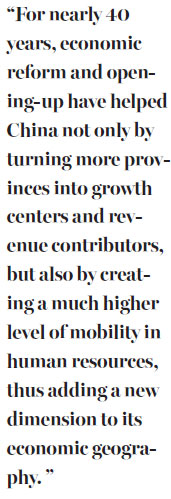Leading areas foretell China's future
Updated: 2016-03-11 08:09
By Ed Zhang(China Daily Europe)
|
|||||||||
Economic geography has always played a key role in history, and the quest for innovation and progress will be no different
One of the most noteworthy parts of China's two sessions (of the national legislature and the political advisory body) this year is the central government's acknowledgement of the country's changing economic geography, and the methodology it adopts to deal with it.
While Li Keqiang, the premier, seems to focus on visiting the local delegations representing the places that scored higher than the national average in GDP growth, President Xi Jinping seems to specialize in the other side of the equation - the places entangled in difficulties as they seek a transition.
Economic geography hardly gets a mention from either economists or political scientists. But it is an important factor in running a large country with changing regional features.

Those who know a little about Chinese history understand that for the past 2,500 years and even longer, economic geography has always been an important factor in the general economic and political picture of a dynasty, and even its very existence.
Just to cite a couple of recent cases: The Kuomintang was defeated by the Communist Party of China partly because it could only effectively control the southeastern part of the country (mainly the Yangtze River Delta), where the intensive work needed for growing rice largely drained human resources it needed to mobilize for the battlefield. In northern China, the loss of farmland (due to many past wars prolonging environmental degradation) and less care demanded by dry land farming could release thousands of young rural men for other purposes.
But the gap between a few pockets in the Yangtze River Delta (mainly Shanghai) and the rest of the country in economic capability remained up to the late 1970s. The central government had to rely on Shanghai for a great part of its revenue and fiscal spending. Only after market-oriented reforms launched in 1978 by Deng Xiaoping and his colleagues did China's economic map begin to change.
As modern business opportunities began to spread, many provinces caught up with and eventually exceeded Shanghai in local GDP and in their contribution to the state coffers. In 2015, three provinces - Guangdong, Jiangsu and Shandong - each scored more than 6 trillion yuan ($921 million; 839 million euros) in GDP. Shanghai ranked only 12th in the GDP list of 31 locations in the Chinese mainland, although in terms of per capita GDP the city is still leading the rest of the nation - along with two other municipalities, Beijing and Tianjin.

Governing a large country requires its leaders to use the regional discrepancy in resources and development as a resource, to narrow the gap in wealth and opportunity distribution rather than leave the gap unattended or let it grow wider, to experiment with new development strategies in selected places and let the successful places serve as role models for the rest of the nation, and at times, to skillfully create and manage some regional gaps so as to spur the laggard places to make a better effort.
For nearly 40 years, economic reform and opening-up have helped China not only by turning more provinces into growth centers and revenue contributors, but also by creating a much higher level of mobility in human resources, thus adding a new dimension to its economic geography.
The country's employment data are so inadequate that they hardly reflect the picture of internal migration. But it's not hard to tell that there are roughly four kinds of valuable human resources in an economy: those who can work hard, such as young workers; those who can or have potential to create more value, such as private entrepreneurs and college graduates; those who contribute to the creative capability of local society, such as college professors and journalists; and those who have guaranteed money to spend, such as the urbanites with retirement benefits. They are all quite mobile in China today.
The net losers of human resources will have no hope for quick progress in the transition hoped for by the central government. They are usually places plagued by rampant corruption, rigid and inadequate civil service, poor economic planning with little local uniqueness, and a consistent grudge against others who seem to do better.
Following the same logic, any place that can attract valuable human resources in one way or another can be net winners in the next round of regional competition for GDP growth and for transition.
There are 14 places that have scored more than 2 trillion yuan in local GDP in 2015. They can afford to quicken their transitions by using not only human resources from other regions of the country, but those from other countries. Watch them, and you'll know how China is going to change next.
The author is editor-at-large of China Daily. Contact the writer at edzhang@chinadaily.com.cn
Today's Top News
Inspectors to cover all of military
Britons embrace 'Super Thursday' elections
Campaign spreads Chinese cooking in the UK
Trump to aim all guns at Hillary Clinton
Labour set to take London after bitter campaign
Labour candidate favourite for London mayor
Fossil footprints bring dinosaurs to life
Buffett optimistic on China's economic transition
Hot Topics
Lunar probe , China growth forecasts, Emission rules get tougher, China seen through 'colored lens', International board,
Editor's Picks

|

|

|

|

|

|







